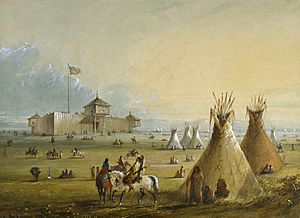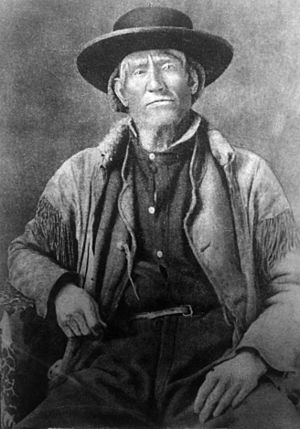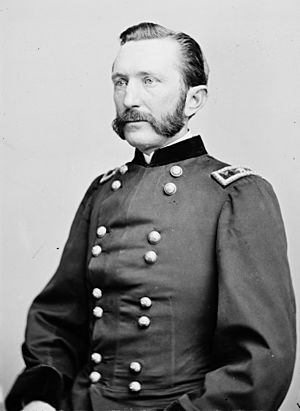Powder River Expedition (1865) facts for kids
Quick facts for kids Powder River Expedition |
|||||||
|---|---|---|---|---|---|---|---|
| Part of the Sioux Wars, American Indian Wars | |||||||
 The Powder River in southeastern Montana where Cole's and Walker's columns passed in 1865. |
|||||||
|
|||||||
| Belligerents | |||||||
| Sioux Cheyenne Arapaho |
|||||||
| Commanders and leaders | |||||||
| Red Cloud Sitting Bull Roman Nose Little Wolf George Bent |
|||||||
| Strength | |||||||
| 2,300 soldiers 179 Indian scouts 195 civilians |
~2,000 warriors | ||||||
| Casualties and losses | |||||||
| 31 killed 15 wounded |
~20 killed 10 wounded 21 captured (including women and children) |
||||||
The Powder River Expedition of 1865 was a big military mission by the United States Army. It was also called the Powder River War or Powder River Invasion. This mission was against the Lakota Sioux, Cheyenne, and Arapaho Native American tribes. It took place in what is now Montana and South Dakota.
Even though the soldiers destroyed one Arapaho village and built Fort Connor to protect gold miners, the expedition is seen as a failure. It did not defeat or scare the Native American tribes.
Contents
Why the Expedition Happened
The Sand Creek massacre happened in November 1864. This event made Native American tribes angry. They started more attacks in the Platte River valley. After these attacks, thousands of Sioux, Cheyenne, and Arapaho people gathered in the Powder River area. This land was far from white settlements. It was also set aside for Native Americans by the 1851 Treaty of Fort Laramie.
The Native Americans saw the Bozeman Trail as a big threat. This trail was created in 1863. It went right through the middle of their lands. Even though the Fort Laramie Treaty allowed roads, the tribes bothered miners and travelers on the trail. In July 1865, over a thousand warriors attacked a bridge in the Battle of Platte Bridge. They managed to stop travel on both the Bozeman and Oregon Trails for a short time. After this battle, the Native Americans split into smaller groups. They went off for their summer buffalo hunt. A weakness of Native American warfare was that they could not keep a large army together for a long time.
General Grenville M. Dodge ordered the Powder River Expedition. He wanted to punish the northern plains tribes in their own territory. General Patrick E. Connor was chosen to lead this mission. General Dodge told Connor to "make vigorous war upon the Indians and punish them so that they will be forced to keep the peace." This campaign was one of the last Native American wars fought by soldiers who had volunteered for the United States Army.

General Connor's plan was to send three groups of soldiers into the Powder River Country.
- The "Right column" had 1,400 soldiers and 140 wagons. Colonel Nelson D. Cole led them. They were to march from Omaha, Nebraska, to the Black Hills. They would meet Connor near the Powder River.
- The "Center Column" had 600 cavalrymen from Kansas. Lieutenant Colonel Samuel Walker led them. They were to go north from Fort Laramie. They would travel west of the Black Hills.
- The "Left" and "West" Columns had 675 men. General Connor himself led them. These soldiers were from California, Iowa, Michigan, Nebraska, and Ohio. They also had Native American scouts and a wagon train. They would go to the Powder River to build a fort near the Bozeman Trail. All three groups were supposed to meet at this new fort.
Connor's orders to his commanders were very harsh. He told them, "You will not receive overtures of peace or submission from Indians, but will attack and kill every male Indian over twelve years of age." However, Connor's bosses, Generals John Pope and Dodge, tried to cancel this order. But it was too late. The three groups had already left and could not be contacted.
The expedition had problems from the very beginning. The number of soldiers for the mission was cut down. It went from 12,000 to less than 3,000. This happened because many soldiers left the army after the American Civil War ended. The remaining volunteer soldiers were "mutinous, dissatisfied, and inefficient." Many of Cole's and Walker's men had fought in the Civil War. Few of the soldiers had experience fighting Native Americans or traveling on the Great Plains. Getting enough supplies was also a big problem.
Connor's Journey
General Patrick E. Connor and his 675 soldiers, Native American scouts, and civilian drivers left Fort Laramie on August 1, 1865. They planned to meet Cole's and Walker's groups. One of his guides was the famous mountain man Jim Bridger. Connor's group went north. In August, they built Fort Connor on the upper Powder River.
Crazy Woman's Fork Skirmish
On August 13, 1865, Captain Frank J. North and his Pawnee Scouts were riding near the Crazy Woman's Fork of the Powder River. North and his scouts saw a small group of Cheyenne warriors. They started to chase them. During the chase, North got separated from his men. The Cheyenne warriors turned on him. One of them wounded North's horse. The Captain used his downed horse as a shield and fought back. Scout Bob White arrived and joined the fight. More Pawnee scouts came, and they wounded several warriors, who then ran away. This fight was the first battle of the Powder River Expedition.
Powder River Attack
Captain North and his Pawnee Scouts followed a group of Cheyennes for two days. The trail showed the Cheyennes had about 40 horses and mules. One travois (a type of sled) carried a wounded warrior. At 2:00 AM on August 16, 1865, North and his scouts caught up with the group. They were on the Powder River, about 50 miles north of Fort Connor. The Cheyennes had camped for the night and were asleep. North decided to wait until dawn to attack. In the morning, his group moved closer to the camp. The Cheyennes saw the scouts but thought they were friendly Cheyennes. They did not act hostile. Then, the Pawnees suddenly charged. They quickly killed all 24 Cheyennes, including Yellow Woman, who was the stepmother of George Bent. The Pawnees lost 4 horses. They captured 18 horses and 17 mules. Many of these animals had government brands, showing they had been taken in recent battles.

Battle of Tongue River
Connor marched north from Fort Connor. On August 28, his Pawnee scouts found an Arapaho village of about 600 people. It was camped on the Tongue River. The next day, August 29, Connor attacked the village. Its leader was Black Bear. Connor had 215 cavalrymen from California, Iowa, and Ohio. He also had over 80 Pawnee, Omaha, and Winnebago Scouts. Most of the people in the village were women, children, and old men. Most of the warriors were away, fighting the Crow tribe. The surprised Native Americans fled the village. But they regrouped and fought back. Connor decided not to chase them further. The soldiers destroyed the village. They captured about 500 horses, and 8 women and 13 children. The women and children were later released. Connor said he killed 63 Arapaho warriors, but this number was probably too high. He lost 2 soldiers killed and 5 wounded. He then marched north into southern Montana before returning to Fort Connor. The Arapaho tribe, who had not been very hostile before, now joined the Sioux and Cheyenne.
Sawyers' Journey
Meanwhile, another group led by Lieutenant Colonel James A. Sawyers was traveling toward the Powder River. This group had 80 wagons, engineers, supplies, and soldiers. The soldiers were from the 5th U.S. Volunteer Infantry. Sawyers' group was supposed to build a new road for people moving to the Montana gold fields.
Battle of Bone Pile Creek
On August 13, 1865, the Sawyers Expedition was moving west. Soldiers from the 5th U.S. Volunteer Infantry were with the wagons. Near Pumpkin Butte, Cheyenne and Sioux warriors attacked the wagons. They killed Nathaniel Hedges, a 19-year-old civilian. Later that evening, the wagons were circled for defense near Bone Pile Creek. Hedges was buried in the middle of the circle. The next morning, the warriors attacked again. They attacked the wagons again on August 15. But they could not take over the wagon train.
Chief Red Cloud of the Sioux and Dull Knife of the Cheyenne talked with Lieutenant Colonel Sawyers. They offered safe passage for the wagons if they received one wagon load of supplies. George Bent and his brother, Charles Bent, of the Cheyenne were also there. Soldiers reported that George Bent was wearing a U.S. military uniform. (Bent later said he had captured a major's uniform coat in January 1865 and wore it during this campaign.) Sawyers agreed to give the supplies. These included a wagon full of sugar, bacon, coffee, flour, and tobacco. When the wagons started moving again, the Native Americans attacked again. They killed Privates Anthony Nelson and John Rawze. The soldiers fired back, killing two warriors. The Native Americans quickly left the wagons. After burying Private Nelson, the Sawyers Expedition continued.
Sawyers' Fight
On September 1, 1865, Arapaho warriors attacked Sawyers' wagon train. They were angry because their village on the Tongue River had been destroyed. They killed three men. Two Arapaho warriors were also killed. The wagon train was stuck for two weeks. Finally, Connor's forces rescued them.
Cole's and Walker's Journeys
The Two Groups Set Out
Colonel Nelson D. Cole left Omaha, Nebraska, on July 1, 1865. He had over 1,400 soldiers and 140 wagons of supplies. His group followed the Loup River upstream. Then they marched across the country to Bear Butte in the Black Hills. They arrived there on August 13, 1865. Cole's group traveled 560 miles. They suffered from thirst, low supplies, and almost had mutinies (soldiers refusing to obey orders).
Lieutenant Colonel Samuel Walker and his 600 Kansas Cavalrymen left Fort Laramie on August 6, 1865. They met Cole's group on August 19, 1865, near the Black Hills. Walker's group also had problems with water shortages. He lost several soldiers from the 16th Regiment Kansas Volunteer Cavalry due to bad water. The two groups marched separately but stayed in contact. They moved west to the Powder River in Montana. By this time, some of the men had no shoes. Many horses and mules were getting weak.
March on Powder River
On September 1, 1865, over 1,400 U.S. soldiers and civilians from Colonel Nelson D. Cole's group were camped on Alkali Creek. This was a small river that flowed into the Powder River in Montana. Early in the morning, over 300 Lakota Sioux warriors attacked the camp's horses. Seven soldiers from the 2nd Missouri Light Artillery Regiment were the first to respond. Warriors ambushed them. Five of these seven soldiers were hurt or killed. Later that night, two more U.S. soldiers were killed while hunting. The Sioux lost four warriors killed and four wounded in this battle.
The next day, September 2, 1865, there were at least three small fights with warriors. In one, at least one warrior was killed. In another, no one was hurt. In the third, two soldiers were killed while returning from a hunting trip. Colonel Cole and Walker desperately needed supplies. They decided to follow the Powder River north. They hoped to find General Patrick E. Connor's group and his wagons. The groups continued north to Mizpah Creek in Montana. There, the two Colonels decided to turn back. They went south up the Powder River to look for Connor's group. The Native Americans attacked again on September 4 and 5, 1865. They kept bothering Cole and Walker as the soldiers moved south.
On September 8, 1865, over 2,000 U.S. soldiers and civilians from Cole's and Walker's groups were marching south. They were on the Powder River in Montana. They did not know that a village of over 2,500 Cheyenne, Sioux, and Arapaho people was camped less than ten miles away. This included the Cheyenne chief Roman Nose. The warriors did not want the soldiers to attack their village, so they attacked first. The soldiers' lead guard, about 25 men, was marching ahead of the main group. This group was hit first. Two of these men were hurt.
Lieutenant Colonel Walker sent a message to Colonel Cole about the attack. At the time, Cole was helping his wagons cross to the east side of the Powder River. Cole ordered the wagons to form a circle for defense. He sent soldiers to clear out Native Americans from the woods along the river. The soldiers pushed the warriors away. Near the end of the fight, another soldier was wounded. At least one Native American was killed. A snowstorm during the night of September 8–9, 1865, caused more problems for the soldiers. Most of them were now walking, their clothes were torn, and they had to eat raw horse meat.
On the morning of September 10, 1865, Cole's and Walker's groups were camped near where the Little Powder River meets the Powder River. Native American warriors appeared. There were some shots fired. On September 11, there were more small fights. On September 13, two scouts from General Connor's group found Walker's and Cole's groups. They told them about the new Fort Connor. Cole, Walker, and their soldiers arrived there on September 20, 1865. Connor decided the soldiers were not fit for more fighting. He sent them back to Fort Laramie, where most of them left the army.
Who Was Hurt
Colonel Cole reported that his eastern group had twelve men killed and two men missing. Lieutenant Colonel Walker reported that his center group had one man killed and four men wounded. Cole claimed that his soldiers had killed two hundred Native Americans. But Walker said, "I cannot say as we killed one." It is likely that Native American casualties were low.
What Happened Next
Connor finally brought all parts of his expedition together on September 24, 1865, at Fort Connor. However, orders were waiting for him there, telling him to go to Utah. The 16th Kansas Volunteer Cavalry stayed to staff Fort Connor. All other troops went back to Fort Laramie. Most of them left the army.
The expedition had some small successes. But it failed to truly defeat or scare the Native Americans. The Cheyenne warrior, George Bent, who fought on September 8, said that the Lakota would have completely destroyed Cole's and Walker's groups if they had more good firearms. Native American resistance to travelers on the Bozeman Trail became stronger than ever. "There will be no more travel on that road until the government takes care of the Indians," a writer said.
The most important result of the expedition was that it convinced the U.S. government to try again. They wanted to build and protect a wagon road from Fort Laramie to the gold fields in Montana. This belief would lead to another invasion of the Powder River country a year later. This led to Red Cloud's War, where the Sioux, Cheyenne, and Arapaho tribes won.
Order of Battle
United States Army
| Division | Column | Regiments and Others |
|---|---|---|
|
Powder River Expedition, Brigadier General Patrick Edward Connor, commanding. |
Left, Western Column
|
|
| Central, Middle Column |
|
|
| Right, Eastern Column |
|
Native Americans
| Native Americans | Tribe | Leaders |
|---|---|---|
| Sioux
|
||
| Cheyenne
|
|
|
| Arapaho
|
|





